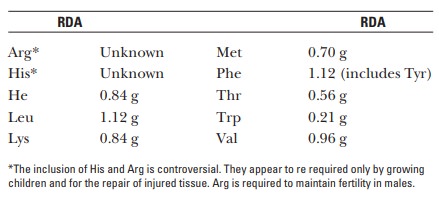Chapter: Biochemistry: The Three-Dimensional Structure of Proteins
Complete Proteins and Nutrition
Complete Proteins and Nutrition
A complete protein is one that provides
all essential amino acids in appropriate amounts for human survival. These
amino acids cannot be synthesized by humans, but they are needed for the
biosynthesis of proteins. Lysine and methionine are two essential amino acids
that are frequently in short supply in plant proteins.
Because grains such as rice and corn are usually poor in lysine, and because beans are usually poor in methionine, vegetarians are at risk for malnutrition unless they eat grains and beans together. This leads to the concept of complementary proteins, mixtures that provide all the essential amino acids-for example, corn and beans in succotash, or a bean burrito made with a corn tortilla. The specific recommended dietary allowances for adult males follow. Adult females who are neither pregnant nor lactat-ing need 20% less than the amounts indicated for adult males.

The protein efficiency ratio (PER) describes how well a pro-tein supplies essential amino acids. This parameter is useful for deciding how much of a food you need to eat. Most college-age, nonpregnant females require 46 g (or about 1.6 oz) of complete protein, and males require 58 g (or about 2 oz) of complete pro-tein per day. If one chooses only a single source of protein for the diet, eggs are perhaps the best choice because they contain high-quality protein. For a female, the need for 1.6 oz of complete protein could be met with 10.7 oz of eggs, or about four whole extra-large eggs. For a male, 13.6 oz of eggs, or a little more than five eggs, would be needed. The same requirement could be met with a lean beef steak, but it would require 345 g, or about 0.75 lb, for a female (or 431 g, or nearly a full pound, for a male) because beef steak has a lower PER. If one ate only corn, it would require 1600 g/day for women and 2000 g/day for men (1600 g is about 3.6 pounds of fresh corn kernels-something in excess of 160 eight-inch ears per day). However, if you simply combine a small amount of beans or peas with the corn, it complements the low amount of lysine in the corn, and the protein is now complete. This can easily be done with normal food portions.

In an
attempt to increase the nutritional value of certain crops that are grown as
food for livestock, scientists have used genetic techniques to create strains
of corn that are much higher in lysine than the wild-type corn. This has proven
effec-tive in increasing growth rates in pigs. Many vegetable crops are now
being produced using biotechnology to increase shelf life, decrease spoilage,
and give crops defenses against insects. These genetically modified foods are
currently a hot spot of debate and controversy.
Related Topics